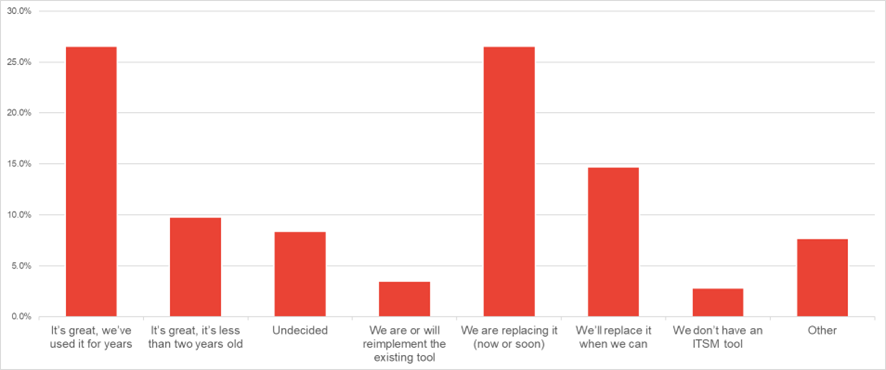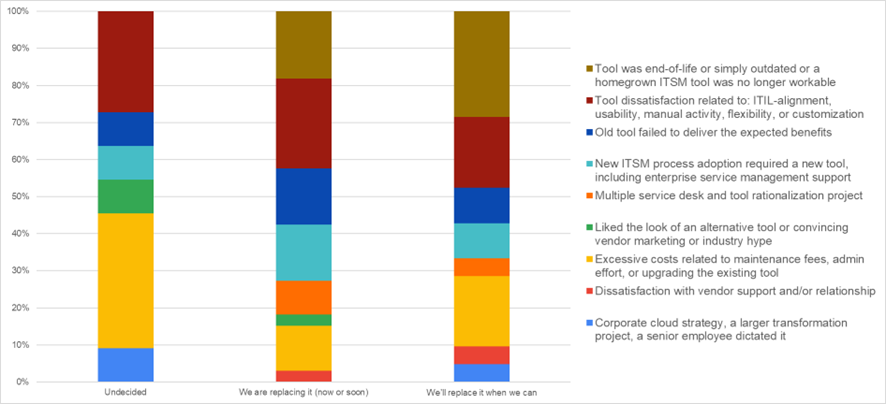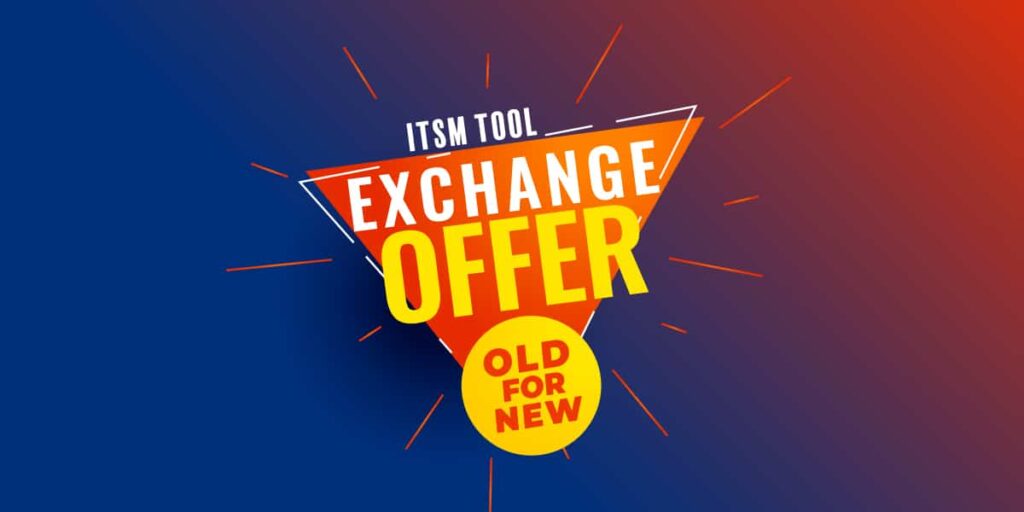ITSM.tools runs a short poll every couple of years to understand why organizations change their IT service management (ITSM) tools. The last poll was run in Q3 2019, with the results shared in this article: Do You Know the Main Reasons Organizations Change ITSM Tool?
For the new poll in Q2 2023, we asked two questions (instead of just the latter one):
- How do you feel about your organization’s primary ITSM tool?
- If you have an ITSM tool – Why did you, or will you, change it? (The primary reason)
This article shares the poll findings along with some insights and opinions on the data. The sample size was 143 respondents.
This article shares data related to how people feel about their #ITSM solution and why people switch (or will switch) tools. Plus, additional insights and opinions based on the data. #servicedesk Click To TweetHow organizations feel about their ITSM tool
There was good news and not-so-good news in this data set. On the one hand, it’s great that over 35% of respondents stated they are happy with their tool (the two “it’s great” columns on the left). On the other hand, over 40% of respondents said they are either replacing or will replace their tool when they can. All these percentages are shown in the chart below.

Sadly, we couldn’t compare the 2023 and 2019 poll results because this question is new. However, the levels of ITSM tool churn seem consistent with what I quoted over ten years ago as an IT industry analyst.
Why organizations have changed or will change their ITSM tool
The chart below shows that the primary reasons for change are consistent with previous surveys (despite my thinking that tool change drivers had become more positive in recent years). The high “other” option is a mix of respondents who are happy with their ITSM tool or have specific reasons for change.

When this data is compared to the polls from 2019 and 2017, there are some interesting insights:
- 2023 is the first time that tool was end-of-life or simply outdated, tool dissatisfaction, and old tool failed to deliver the expected benefits weren’t the top three placed reasons.
- Excessive costs has jumped from 6th to 2nd, doubling its percentage score between 2019 and 2023, perhaps a sign of the post-pandemic economy.
- New ITSM process adoption has risen one place to 3rd and is the only “positive”reason for change in the top four.
- The top three range is closer than ever in 2023 –13%-16%, versus 14%-23% in 2019 and 12%-18% in 2017.
| The primary reason for ITSM tool change | 2023 | 2019 | 2017 |
|---|---|---|---|
| 1. Tool dissatisfaction | 16% | 19% (2nd) | 18% (1st) |
| 2. Excessive costs | 14% | 7% (6th) | 10% (4th) |
| 3. New ITSM process adoption | 13% | 12% (4th) | 10% (4th) |
| 4. Tool was end-of-life or simply outdated | 13% | 23% (1st) | 12% (3rd) |
There is likely sample bias in this data, as in most surveys, but it’s hard to argue with tool dissatisfaction consistently being in the top two across all three polls. Interestingly, “Old tool failed to deliver the expected benefits” was second in 2017 and third in 2019 but only fifth in 2023. This downward trend seems to go against the IT industry’s growing focus on value.
The addition of the first question shows that the 2023 data potentially covers a wide timeframe because the statistics include the organizations that have been happy with their ITSM tool for over four years. To dig deeper into this impact, the following section isolates the reason for change for those organizations either changing or planning to change tool.
What’s driving the current ITSM tool replacements?
The chart below shows that the reasons for change vary considerably across the “undecided,” “we are replacing it,” and “we’ll replace it when we can” options.

To better understand these rainbows of colors, the table below looks at the chart source data in more detail to highlight that tool dissatisfaction, tool was end-of-life, and excessive costs are the only options to appear in the top two reasons for change (with the excessive costs 5th place for organizations currently replacing their ITSM tool the only blip in a “clean sweep”). However, it should be noted that the sample here has been reduced from 143 to a lowly 65.
| Excessive costs | New ITSM process adoption | Old tool failed to deliver | Tool dissatisfaction | Tool was end-of-life | |
|---|---|---|---|---|---|
| Undecided | 1st | 3rd | 3rd | 2nd | - |
| We are replacing it | 5th | 3rd | 3rd | 1st | 2nd |
| We’ll replace it when we can | 2nd | 4th | 4th | 2nd | 1st |
What this all means
The last data set offers the most relevant insight into the current state of tool churn, given that it distills down the primary reasons for ITSM tool change for the most recent tool-changing organizations.
As the table shows, we as an industry are still changing due to what I consider “negative” reasons, i.e. we are moving away from the incumbent ITSM tool rather than moving toward its replacement. Sadly, there’s still much that we can’t see from these simple polls. For example, whether tool dissatisfaction is caused by the tool’s capabilities or the implementation of the tool. Or whether the excessive costs relate to the tool itself or the additional costs incurred through missing capabilities such as automation.
'The #ITSM tool churn I first saw 15 years ago is still with us and doesn’t seem to be slowing down yet.' – @StephenMann #ServiceDesk Click To TweetIn terms of the difference between the overall and the subset rankings, it could be that the reason for changing tool becomes more positive in hindsight, with the organizations who are happy with their ITSM tool reporting their motivation for change as new process adoption now, but was it so over four years ago? Sadly we can’t tell from the data.
Finally, I’m still hopeful that the ITSM community will eventually change for positive rather than negative reasons. However, I appreciate that when tool A is considered better than tool B, an organization could either see this as dissatisfaction with B or the opportunity of A (in a “glass half empty” way).
One thing is certain, though: the tool churn I first saw 15 years ago is still with us and doesn’t seem to be slowing down yet.
Stephen Mann
Principal Analyst and Content Director at the ITSM-focused industry analyst firm ITSM.tools. Also an independent IT and IT service management marketing content creator, and a frequent blogger, writer, and presenter on the challenges and opportunities for IT service management professionals.
Previously held positions in IT research and analysis (at IT industry analyst firms Ovum and Forrester and the UK Post Office), IT service management consultancy, enterprise IT service desk and IT service management, IT asset management, innovation and creativity facilitation, project management, finance consultancy, internal audit, and product marketing for a SaaS IT service management technology vendor.

